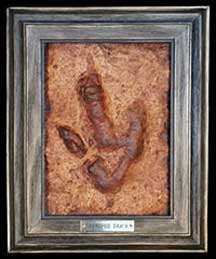Fossilized footprints can be a very valuable resource in understanding dinosaurs and other prehistoric creatures. Ichnology, or the study of ancient animal tracks and traces has become and important branch of paleontology. Fossilized tracks are a form of trace fossil. Unlike skeletal remains, trace fossils represent the activities of the creatures that left them. By studying skeletal remains along with trace fossils, paleontologists are able to see a more complete view of the fossil record.
There are a few good explanations for how a track may become fossilized. Most tracks were formed on a beach or riverbank in mud or moist sand. The simplest explanation for the formation of many fossilized tracks is that the animal left a track in moist sediment which later became hardened by the sun. Then the hardened sediment was covered by more sediments, making it possible for fossilization to occur. Since an animal was capable of leaving behind millions of tracks during a lifetime, but only one skeleton, fossilized track are not as rare as once thought. Still, a well preserved track is a precious paleontological find.
Skeletal fossil remains and trace fossils do not always coincide, often making it difficult to say with certainty which specific dinosaur a track was made by. This theropod track replica was molded from a track found near Moab, Utah. "Theropod" is a term used to classify a group of bipedal carnivorous dinosaurs. The theropod which made this track was fairly small (roughly 2-1/2 feet tall at the hip). This track is Mid to Late Jurassic in age (approximately 150-155 million years old) and was found in the Entrada Formation. Tracks left by this particular dinosaur are somewhat rare to the Entrada Formation.
This specimen was cast with the permission of the Dinosaur Trackers Research Group.
Theropod Track 
Quantity in Basket: None
Code: TRA-100
Price: $207.00
Shipping Weight: 1.79 pounds
Time: Mid to Late Jurassic Period 150 - 155 million years ago.
Location: Entrada Formation of Utah, USA
Dimensions: 11-3/4" x 9-1/2" x 1-1/2"